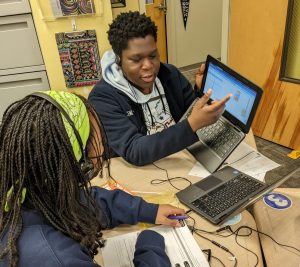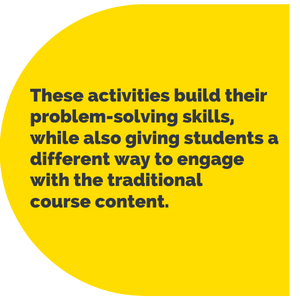Salsa music filled the air as students walked into Spanish I at North Star Academy Washington Park High School in Newark on a recent morning. One by one, they greeted their teacher, Mya Rodriguez-Mendoza, with “Buenos días” and opened their laptops. But instead of tackling a traditional lesson, they dove into something new: Creating a Spanish vocabulary quiz game by using basic tools of computer science.
Students were learning to use Scratch, a programming language, to decorate their own online landscapes with virtual apples, bears and other images, called “sprites.” Then they added questions and answers about their digital scenes in Spanish.
“Look, I did it!” exclaimed one student who had been struggling to remove a basketball she no longer wanted. “I figured out how to hide the sprite!”
‘Aha’ moments like these are the goal of an Uncommon initiative that aims to vastly expand the reach of computer science. Our hypothesis is that if we help students build an identity in computer science and show them that coding is for them – by making it engaging, accessible, and relevant to their personal interests – they will be more likely to take a computer science course in high school and pursue it as a major in college.
We can test this hypothesis, thanks to a five-year, $4-million Education Innovation and Research grant from the U.S. Department of Education. Starting this year, Uncommon is embedding computational thinking – a broad skill set that includes coding and data science – into five courses for ninth and tenth graders, including Ancient World History, Biology, Chemistry and Geometry. The goal is ensuring that all students are exposed to coding early on, so they will be more likely to opt into advanced computer science classes. We want all our high school students to gain confidence in this realm and reject widespread misconceptions that only certain tech-savvy students can handle its rigor.
Research has shown that many Black and Latinx students have internalized negative stereotypes implying they don’t belong in computer science. Nationwide, only 6% of students taking AP Computer Science exams were Black, 16% were Latinx, and 31% were women in 2020, according to a report in Code.org, a nonprofit dedicated to computer science.
Our initiative aims to fight such inequities and boost the number of women and people of color entering lucrative tech careers. Employment in the computer and IT sector is projected to grow 15% in the coming decade, by federal estimates, with more than 418,000 openings yearly nationwide. The median annual wage for this field topped $97,000 last year, more than double the median for all occupations. Beyond that, many jobs outside of technology now require familiarity with basic tech skills.
418,000 openings yearly nationwide. The median annual wage for this field topped $97,000 last year, more than double the median for all occupations. Beyond that, many jobs outside of technology now require familiarity with basic tech skills.
Uncommon will embed programming projects in general education courses so students won’t need to self-select into computer science to enjoy its immense satisfaction. In this randomized controlled trial, an independent research partner, Mathematica, picked five of our high schools at random to add computational thinking units to the core curriculum in ninth and tenth grades. All nine of our high schools will do so starting in fall 2024.
“It Rewires How They Think”
The first phase of our initiative rolled out this fall with modules in three core classes. The modules were designed to have students work in partners via Nearpod, using step-by-step instructional videos to pursue a task over the course of a week.
- Geometry students used Scratch, a block-based coding language, to build an app for visualizing transformations of shapes in a plane (i.e., reflection, rotation, and translation).
- Biology students first learned basic data analysis skills, such as sorting and filtering data, using a Spotify data set. Then they applied those skills to a large ocean acidification data set from the National Oceanic and Atmospheric Administration to answer the question of how ocean acidification affects marine life.

- Spanish I students learned basic programming fundamentals including variables, conditionals, and iteration, as they created their own vocabulary quiz game.

Teachers had one afternoon of professional development and tried the same activities their students would tackle. We emphasized the importance of staying positive, modeling resilience, and helping students see themselves as capable problem-solvers who can use technology to create their own tools – even if they don’t complete every single step of the task in the week allotted.
Kimberly Arnold, who teaches Spanish I at Lincoln Park High School in Newark, was thrilled to see students’ enthusiasm. “I’ve seen a lot of examples of strong engagement and students wanting to use this as a tool not only to improve their Spanish, but to show their own creativity,” she said. “It kind of rewires how they think about learning.”
Debunking 5 Myths about Computer Science for All
So much became clear as we moved from planning into implementation, and some key assumptions were quickly debunked.
Myth #1: Coding would feel more natural in science or math than in humanities classes.
- Reality: Coding is its own skill that feels just as new in Geometry as it does in Spanish. Indeed, we saw that student engagement was highest in classrooms where teachers embraced this new experience, both in the way they framed it for students and in their own preparation – regardless of the content area.
Myth #2: Asynchronous modules would work best.
- Reality: The rationale behind asynchronous modules (relying heavily on instructional videos) was to make the lessons as manageable as possible for teachers and create a seamless learning experience for students. In practice, it was (understandably!) difficult for teachers to support students who were all in slightly different stages and experiencing unique challenges – some students had trouble with the coding content, others with navigating through the Nearpod deck and the videos. We found that most teachers wanted to have a more active role in the instruction, allowing them to better support students and tailor lessons to their needs.
Myth #3: Completing the student activities would be sufficient preparation for teachers.
- Reality: If we truly want students to build self-efficacy in computer science, we first have to help teachers do the same – and that can’t be done in three hours over Zoom. Initial survey data suggests that teachers craved more time to learn the content themselves before thinking about how to best support students. We
 need to find a way to give them the time and space to do that within the confines of an already-packed teaching and professional development schedule.
need to find a way to give them the time and space to do that within the confines of an already-packed teaching and professional development schedule.
Myth #4: Stand-alone modules are the most effective way to deliver computational thinking content.
- Reality: A one-week module does not appear to be sufficient to help students build a comfort level with a new technology and create meaningful artifacts of their learning. Although we haven’t yet seen the student survey and focus group data, classroom observations and conversations with teachers suggest that a better approach might be to introduce the technology (i.e., Scratch or Google Sheets) during the first month of the school year, and then embed shorter activities throughout the year that allow students to build a computational thinking mindset and practice the specific skill (i.e., coding or data science) so that it has a higher likelihood of “sticking.”
Myth #5: Everyone already knows what coding is and why students should learn it.
- Reality: Although the idea of coding in schools is now fairly mainstream, with activities like Hour of Code commonplace and extracurricular coding clubs popping up every day, the truth is that many students (and, importantly, many teachers) have never had a hands-on coding experience. What a privilege, then, to craft a first experience that can be powerful and intellectually fulfilling! With that privilege comes a responsibility to generate excitement about the possibilities of coding – potentially by using videos such as this one from code.org, and posters of CS Heroes and other resources from the Computer Science Teachers Association.
Next Steps
Early feedback from teachers and students informed some changes to the second round of modules, Python coding in Chemistry and another Scratch project in Ancient World History, which will roll out this spring.

- Instructional changes: Enabling more teacher-student interaction, especially while students are getting comfortable with the new tool or programming language. Designing activities that build in “quick wins” while students are learning the technology. Incorporating more opportunities for creativity once they have mastered the basics. Leveraging instructional videos for more complex programming tasks.
- Changes to teacher training: Teachers will learn the basic computational thinking content asynchronously, prior to the 3-hour Zoom training. In the synchronous meeting, they can deepen their own understanding of the content and practice the teaching strategies they will use.
Celebrating the Wins
Some positive feedback from this first round suggests that – with some significant tweaks – this model may be the key to making computational thinking part of what we do at Uncommon. Seeing students create a game or figure out why their graph is not displaying as expected in Google Sheets shows these activities build their problem-solving skills, while also giving students a different way to engage with the traditional course content.
“I like making a whole new world out of just blocks of code,” said Nia, a ninth grader at Lincoln Park. “I’ve always been imaginative, and it’s fun knowing that I can teach people new things in my own personal world.”
Despite some implementation hurdles, many teachers were delighted at the benefits. Megan Nolan, a Geometry teacher at Washington Park, said students were collaborating with an intensity she hadn’t seen since the Covid lockdowns. Anntania Emanuel, a Biology teacher at Camden Prep High School, said it was important for students to learn to embrace change and explore.

“This is a tool not only for students to learn about coding, but also to learn something new and get out of the typical classroom environment,” said Ms. Arnold, at Lincoln Park. “This is a hands-on way for students to apply what they know while applying their own creativity.”



